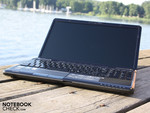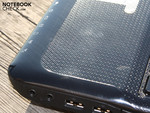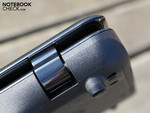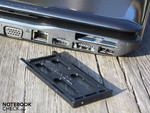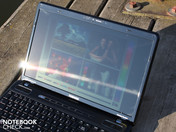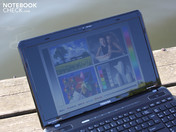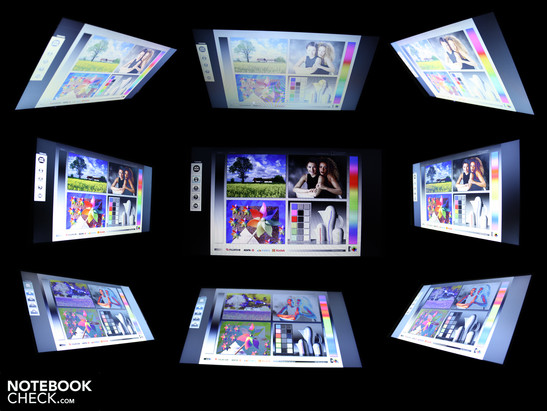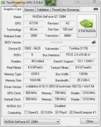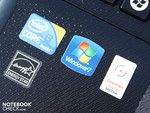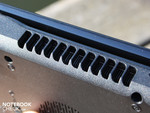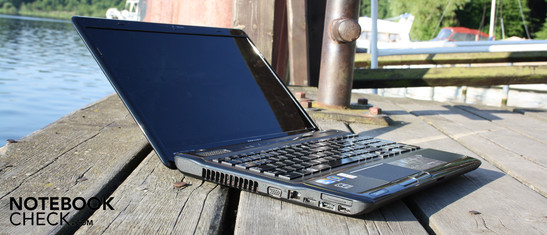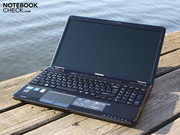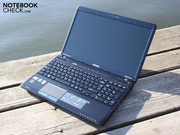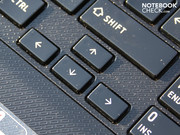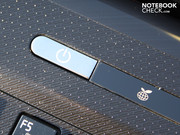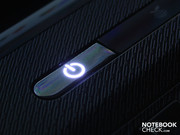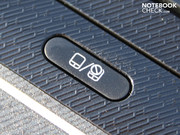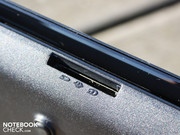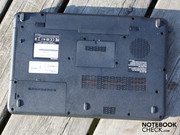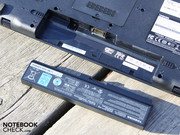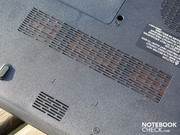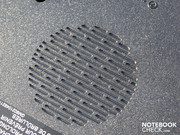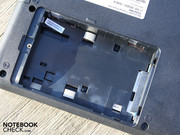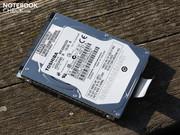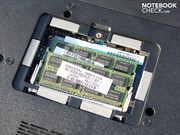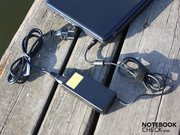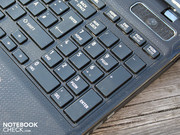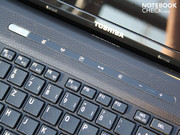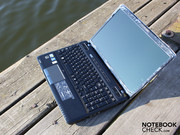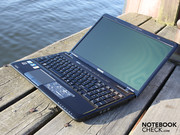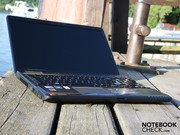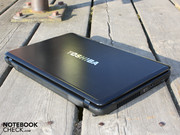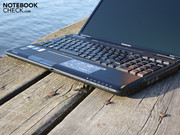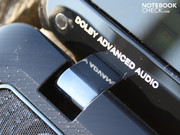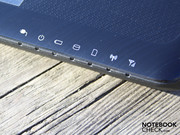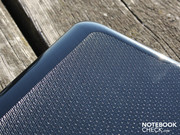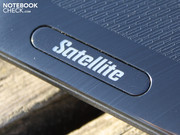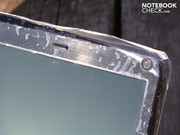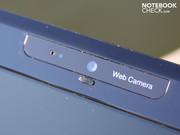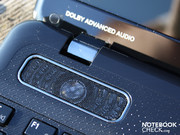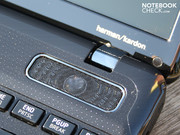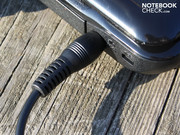Review Toshiba Satellite A660-151 Notebook

The manufacturer, Toshiba, offers a wide range under its consumer label "Satellite". Starting with the Satellite A500-1GP (multimedia all rounder starting at 715 euro), over the Pro C650 (office starting at 500 euro) and the P500-18U (Core i5 aligned for performance starting at 1000 euro) or the L550-207 (ATI gamer starting at 660 euro), there's something in the program in every price category.
The Satellite A660-151 belongs to the middle price range with a market price starting at 730 euro. It comes along with a strong dedicated graphics solution as an Nvidia GeForce GT330M. This GPU is Nvidia's gaming starter and can keep up quite well with the popular ATI HD5650. The smallest Arrandale processor from Intel, the Core i3-330M without Turbo Boost, is also built in. Find out if these components make a good impression in combination with Toshiba's not any longer quite so brilliant chassis in our detailed review.
Case
Toshiba has always liked to use high-gloss for its multimedia models. This sometimes even included the wrist-rests, and many users didn't find it at all agreeable, at least at second glance. The last test device of this kind was the Satellite L670D-120 with a good value for money ratio.
Now the manufacturer limits the oily-finger-susceptibility a bit with a reversed design. The lid is still glossy, but a pattern (many small squares) with a haptical grip covers the surface. This area, which is continued on the wrist-rest, is almost completely resistant against fingerprints. In opposition, the edges of the lid and base unit are smooth.
The case is basically solid, but shows considerable construction weaknesses on the right. A finger can dent the right wrist-rest with medium pressure. The hard disk is beneath it. The number block over the optical drive yields obviously under slight pressure and pushes on the DVD tray beneath it.
Otherwise, the workmanship makes the impression of an average quality case due to even gaps. The smooth plastic doesn't give the 16 incher a high-end look & feel, though. The expression "plastic box" meets our impression quite laconically.
The lid makes an overall very stiff impression and can only be twisted by a few degrees with both hands. The surface can't avert a slight denting against medium pressure, though.
The hinges have a firm grip on the heavy lid, but they tend to teeter slightly. Although the lid has a tight fit, the user only needs one hand to open it. The reason for this is the case's high counterweight. The hinges sit exceptionally tight in their latch. The silver cap over the hinges is plastic and doesn't have a relevant function. Unfortunately, the hinges don't have a clear stop at the maximum opening angle (about 45 degrees) and teeter extremely there. The maximum opening angle is sufficient for a use on the lap.
The base plate is made of simple plastic and can only be dent in the area of the big vent. Both openings on the bottom bid the option of exchanging hard disk and RAM. However, the user can't access the WLAN module, also inserted, as easily. The entire base plate has to be removed for this.
Connectivity
Toshiba equips its 16 incher with the most important connections. The available place on the right and left is used, but FireWire or a DisplayPort, which would certainly also have had room, have been left out in favor of a very wide air outlet. The A660-151 is equipped with sufficient connection option for the price category; even eSATA and ExpressCard34 haven't been left out.
Connections on the rear would have provided for more order on the desk. There aren't any ports because the battery and the low mounted display hinges prevent it. The ports for cables exclusively on the front places (right & left) could have a negative or at least disturbing effect, depending on the application case. If you imagine a massive cabling with eSATA and HDMI (left), as well as audio and 2 USB (right), you'll see an extreme cable harness that obstructs the desk on both sides. Righties and lefties are disadvantaged in this case. The connections haven't been placed ergonomically for a multimedia notebook that will tend to be extremely cabled.
If you rather use wireless connections for data transfer, you can do that in draft-n standard. The Atheros AR9285 wireless network adapter supports the current standard. High speed isn't available on the wired side. The Realtek FE Family Controller is only capable of Fast Ethernet (10/100 MBit). The gigabit switch at home can thus remain idle. Also not present: Bluetooth for connecting to headsets, smartphones or navigation systems.
Input Devices
Keyboard
Toshiba builds in a keyboard with detached keys and uses the entire width of the 16 inch case for it. The keys may not have desktop size, but they have a large gap in between. This allows typists an accurate typing. A patterned crosspiece is between the keys, which partly covers large areas. The generous layout is most obvious on the arrow keys. The arrow keys are finally not any longer squeezed into the layout, but can spread downwards instead. Even the number pad has the privilege to escape the key rectangle.
The keys have a pleasantly distinct pressure point, a long stroke length and a fairly firm stroke. Unfortunately, the clear key stroke suffers due to the coiling surface on the right (yields). The area over the DVD drive is affected.
Regrettably, the keys are slippery. Toshiba hasn't given them a glossy finish, but the smooth coat doesn't bid fingertips a particularly good grip. Depending on the sensitivity, the user may also sense an oily feeling because the keys collect one fingerprint after the other. Toshiba jeopardizes what had started with a good feedback and a generous layout with the smooth key surfaces.
Touchpad
The multi-touch mouse replacement is placed flush in the wrist-rest, but it's made of a matt material. However, we always know where the fingers are due to the different haptics (the wrist-rest has a rougher pattern). The surface has a pleasant, medium frictional resistance and allows the cursor to move precisely over the desktop.
The pad's surface is very large and also sensitive for movements up to its edges. The white markings in the upper area continuously glows and shows the pad's position. As soon as the mouse pad is disabled by the key above it, the light extinguishes.
The touch surface has a vertical and horizontal scroll bar. Their zone isn't visibly marked and that for good reason. Users can disable the scroll bar with the Synaptics Touchpad V7.4 software or increase/decrease its surface size. If you want to use multi-finger control, you can do without the scroll bar. Scrolling also works with two fingers, and two fingers are spread for zooming. The keys have a short stroke length, a slightly obtrusive click with a high pitch and a slippery surface.
Display
The Toshiba A660-151 with a Samsung screen (type LTN154X3-L06) has a resolution of 1366x768 pixels (aspect ratio 16:9). This WXGA resolution is relatively coarse for a 16 incher but acceptable. In view of gaming ambitions, a GeForce GT 330M wouldn't have been able to display current games in WSXGA or even Full HD (1920x1080) anyway.
The Samsung screen only has a poor contrast of 167:1. Such a low rate is typical for inexpensive office notebooks. Potential buyers with high demands on color fidelity, or at least brilliant colors, won't be satisfied with the A660 display. The glare type (reflective surface) improves the contrasts optically, but there aren't any really brilliant colors. Better contrasts would have been desirable for the color perception of movies, pictures and games, but are almost never found in the price category under 1000 euro.
| |||||||||||||||||||||||||
Brightness Distribution: 90 %
Center on Battery: 179 cd/m²
Contrast: 167:1 (Black: 1.07 cd/m²)
The luminance measurement on the TFT unfortunately only supplies below average results. The average is 178 cd/m2. The illumination is very even (90%). If you look at a black surface, you won't see any staining. We need a maximum luminance of 150 cd/m2 indoors. This brightness is fully sufficient for movies, games or office tasks.
The screen's brightness isn't at all sufficient in sunlight. The missing AR coat is also a factor that provides for annoying reflections. Users don't have a chance of a fairly pleasant, ergonomic view in intense sunlight.
The Toshiba A660-151 performs like 90% of its classmates in all possible viewing angles. A deviation of up to a maximum of 45 degrees is possible without losses on the horizontal plane. The image deterioration turns up faster and more severe on the vertical plane. The colors already invert and writing can only be read with much difficulty due to dimming at 20 degrees. The Satellite A660-151's narrow vertical viewing angles are very obvious on the picture.
Performance
The Core i3-330M belongs to the weakest Intel Arrandale processors with 2 x 2.13 GHz (L2 cache, 3MB), that is if the UM alternative (ultra low voltage) aren't considered. The maximum thermal design power (TDP) of this CPU is 35 watts. Intel Core i3-350M notebook processor. The processor is capable of hyperthreading (HT). All Core ix CPUs have this feature. HT provides every physical core with a virtual core. The dual corer can thus compute with four threads. The Penryn predecessor generation Core 2 Duo wasn't capable of hyperthreading, but the new Intel Atom chip is.
Furthermore, 4096 MB DDR3 is inserted in two modules with 2048 MB each. They can be used completely by the 64bit Windows 7. The Nvidia graphic card doesn't use Shared Memory. That means it can't claim a part of the RAM for itself.
The i3-330M has a IGP graphic card, like the i5 range. The manufacturer has disabled the Intel HD in the test device in favor of the dedicated Nvidia Geforce GT 330M (1024 MB GDDR3). We've already had this Nvidia midrange GPU in review. More about graphics in the section "Gaming Performance".
With the Core i3-330M (2.13 GHz), the Toshiba A660-151 might not be equipped with a high-end processor (no Turbo Boost as in the Core i5-XXX), but the computing speed in multi-core calculation is higher than similarly clocked Core 2 Duo CPUs. An Intel T6600 (2.2 GHz) achieves 4948 points in Cinebench R10 Multi (64bit). Our test device scores 6579 points. The reason for the computing performance's improvement despite the low clock rate is hyperthreading (HT). Whilst the i3-330M computes with four threads at the same time, the Core 2 Duo works with its two native cores.
The i3-330M is on par with its Core 2 Duo predecessor in single-core calculations, though. The computing rate is now only slightly above a T6600 (2.20 GHz). Cinebench R10 Single (64bit) determines 2916 versus 2633 points (i3-330M vs. T6600).
| PCMark 05 Standard | 5958 points | |
| PCMark Vantage Result | 5052 points | |
Help | ||
PCMark Vantage establishes a typical rate of 5052 points for Core i3 systems with dedicated graphics. All components are assessed in this test, starting with the processor over the hard disk up to the RAM (system performance).
Due to hyperthreading, the Satellite A660-151 reaches a performance for which an Alienware M17 (Intel QX9300, HD3870, 4.902 points) or a gaming machine like Cyber System QX18 (T9900, GeForce GTX 280M SLI, 4.832 points) would have been needed two years ago. The strong graphic cards in these machines don't have a big impact on the application performance test, though. What counts is a quick processor (multi-core), a fast hard disk and a strong RAM
However, compared to current Intel Cores, the Satellite A660-151 has to be called a starter. A Samsung NP-R580-JS03DE (i5-520M) is considerably faster with 6026 points, just like a Sony Vaio VPC-F11Z1/E (i7-720QM) with 5844 points. AMD's Phenom II X4 N930 quad core processor is below the Intel test system with 4380 points (Acer Aspire 7551G-N934G64Bn, HD 5650).
| 3DMark 03 Standard | 17795 points | |
| 3DMark 05 Standard | 12161 points | |
| 3DMark 06 Standard Score | 5922 points | |
Help | ||
The hard disk with a capacity of 320 GB is from Toshiba (Toshiba MK3265GSX) and rotates with 5400 rpm. Its speed is good but not overwhelming. We measured 61.3 MB per second with HDTune (sequential read). The best 2.5 inch notebook HDDs accomplish more than 70 MB per second in sequential read with the same revolution speed.
An Nvidia GeForce GT 330M with a 1024 MB DDR3 memory renders the image as the GPU in the A660-151 (core: 575, memory: 790 MHz). The clock rate corresponds to the standard that we've found in all GT 330M notebooks until now. Technically, the memory can run up to 1066 MHz.
In opposition to the ATI 5 series, the GPU is not capable of DirectX 11, but has the DirectX 10.1, Shader 4.1 status quo of 2009. DirectX shouldn't be relevant for the purchase decision because the GPU is too weak to render this image quality smoothly. That's why we didn't try DirectX 11 games like Metro 2033, either.
3DMark2006 closes with 5922 points. Thus, the GT 330M is on par with a Mobility Radeon HD 4650 (about 5713 points). But the GT 330M doesn't come close to an ATI HD 5650: 6540 points (Acer Aspire 8942G-334G64Mn, i3-330M).
Modern Warfare 2
Infinity Wards shooter is a must because it can be played on many mainstream notebooks with its low hardware demand. At low settings run it runs at full 107 fps. The game runs with 36 fps in medium settings (2xAA, medium details) and 1024x768 pixels. There's not much room left for increasing to 1366x768 pixels (high, 4xAA). Nevertheless, the shooter remains still just playable in the native resolution with 30 fps. First a GeForce GTS 250M (49 fps, high) or a GeForce GTX 285M (61 fps, high) boost Modern Warfare 2 into gamers' heaven.
| CoD Modern Warfare 2 | |||
| Resolution | Settings | Value | |
| 1366x768 | all on/high vsync off, high textures, 4xAA | 30.5 fps | |
| 1024x768 | all on/med vsync off, normal textures, 2xAA | 36.3 fps | |
| 800x600 | all off/low vsync off, low textures, 0xAA | 107.6 fps | |
Die Sims 3
The popular pastime from Electronic Arts can be enjoyed on the Satellite A660-151 without restrictions. The world is animated at a smooth 32 fps in 1280x1024 pixels (external monitor; similarly native 1366x768). In case you do experience stutters, you can reduce the details maximum in the highest resolution and get a perfectly smooth game play. Sims 3 doesn't have any high demands on hardware and even runs smoothly with a Radeon HD 4570 (32 fps, high).
| Sims 3 | |||
| Resolution | Settings | Value | |
| 1280x1024 | high / all on, high AA | 31.8 fps | |
| 1024x768 | med / all on | 61.9 fps | |
| 800x600 | low / off | 279 fps | |
Gaming Verdict
Games with a fairly low demand run smoothly. Current high-end games shouldn't be on the wish list. The Core i3 CPU limits the game play, as we had to find out in the Medion Akoya P7615 (i3-330M, GT 330M) in Battlefield: Bad Company 2 and Metro 2033. There, the frame rate turned out lower than it would have actually been expected from the GT 330M.
With an ATI HD 5650 and a Turbo Boost processor starting with Core i5 or better current games run smooth in medium/high details. Nevertheless, occasional gamers will find numerous older or less demanding current games that run smooth and in high details.
| low | med. | high | ultra | |
| Call of Juarez Benchmark (2006) | 14.7 | |||
| Sims 3 (2009) | 279 | 61.9 | 31.8 | |
| CoD Modern Warfare 2 (2009) | 107.6 | 36.3 | 30.5 |
Emissions
System Noise
We don't put the most stringent demands on multimedia laptops in terms of system noise. But we don't have to with the Satellite A660-151 because it surpasses our expectation in office mode. The fan sways between inactivity (29.4 dB(A)) and lowest activity (31.8 dB(A)) with no load for processor and graphics.
If you surf a bit and write emails, you'll experience a consistently rotating fan at 32.4 dB(A). Even sensitive natures should not be disturbed by that. The Toshiba HDD is only audible due to a basic noise in use. But we did have to put an ear on the wrist-rest. The read and write heads are hardly perceptible.
Ambitioned gamers have to cope with a lot more system noise. The cooling system turns up to 42.6 dB(A) during gaming or under processor load. The noise is constant, but it can't be ignored. The fan is prompted to turn up to full by the stress test (Furmark & Prime95): 42.7 dB(A). The fan runs constant here, too.
Noise Level
| Idle |
| 29.4 / 31.8 / 32.4 dB(A) |
| HDD |
| 30.1 dB(A) |
| DVD |
| 33.8 / dB(A) |
| Load |
| 42.8 / 42.7 dB(A) |
 | ||
30 dB silent 40 dB(A) audible 50 dB(A) loud |
||
min: | ||
Temperature
The Toshiba-A660-151's waste heat is in accordance to the system noise: The 16 incher gets quite warm in gaming and under stress, but stays cool in idle or undemanding office mode. The bottom's average temperature is only 33 degrees in idle, whereby 36 degrees aren't surpassed. The room temperature was very high with 26.3 degrees during the measurement, which is why we say the waste heat is low. A normal room temperature of 21 degrees would let the temperature sink by a guessed five degrees.
The temperature on the processor increases to 81 degrees Celsius during maximum load (stress test), which isn't alarming, though. The work surface now heats up to almost 40 degrees (average) and even exceeds 42 degrees in the vents vicinity. A use on the lap is now at the latest unpleasant with an average of 38 degrees. The adapter gets very warm with up to 52 degrees at the tethered effective power of 70.2 watts.
(±) The maximum temperature on the upper side is 42.8 °C / 109 F, compared to the average of 36.9 °C / 98 F, ranging from 21.1 to 71 °C for the class Multimedia.
(-) The bottom heats up to a maximum of 45.7 °C / 114 F, compared to the average of 39.1 °C / 102 F
(±) In idle usage, the average temperature for the upper side is 32.4 °C / 90 F, compared to the device average of 31.2 °C / 88 F.
(-) The palmrests and touchpad can get very hot to the touch with a maximum of 40.1 °C / 104.2 F.
(-) The average temperature of the palmrest area of similar devices was 28.8 °C / 83.8 F (-11.3 °C / -20.4 F).
Loudspeakers
Toshiba doesn't treat its 16 incher to a subwoofer, but high-quality Harman/Kardon stereo loudspeakers instead. The so-called "Bass Enhanced Sound System with Dolby Advanced Audio" doesn't miss its effect. Strong basses and a balanced sound accompany us in computer games and music. The speaker's membranes even make the chassis vibrate slightly, which is especially enjoyable in games.
Nevertheless, potential buyers shouldn't have any excessively high hi-fi expectations. The high volume and the balance of the midranges, low pitches and trebles allow for listening to music in a room. But the few watts can't compete with an external system.
Unfortunately, the external system can only receive the signal via the analog headphone-out, or via the soundtrack in HDMI. SPDIF isn't available. The static-free audio-out has a strong level, which should be sufficient for unamplified stereo speakers to about 15 watts.
Battery Life
The 16 incher can't achieve any long runtimes with the 48 watt hour battery. Internet surfing with enabled WLAN ends after 2:11 hours (131 minutes). We called up websites that put the processor under a load of 10 to 20% with flash banners. The luminance was just room suitable with 100 cd/m2.
The DVD movie came to its end after 2:05 hours (125 minutes). The battery is ready for the next movie night in the same time (2:05 hours). This is the time the battery needs for recharging after a complete drain. Our real-life test of listening to music and playing an AVI movie from the hard disk confirms the DVD runtime. The illuminated Satellite logo stopped glowing after 130 minutes.
The maximum runtime in idle is only 2:55 hours (175 minutes). The luminance was set to the lowest level and the wireless module disabled.
Toshiba A660-151's short battery life suggest a high power consumption. But that's not at all true. The battery life suffers due to the weak 4200 mAh battery. When all energy savings options are exhausted, the idle power consumption is only 13.6 watts. That's a good average, but could be better as the following two 17 inchers prove. An Asus N71JV (GT 330M) is more energy saving and merely draws 12.1 watt from the mains in minimum state. The Samsung R780-JS03DE (i5-520M, GT 330M) needs 14.2 watts.
The effective power (always without battery charging) increases to 55.3, respectively 70.2 watts under load. We measured the 55 watts in a 3DMark2006, which should comply with a 3D game. The 77 watts from the stress test are unrealistic for user's mode, because it's been measured with 100 percent load on GPU and CPU.
| Off / Standby | |
| Idle | |
| Load |
|
Verdict
Toshiba's A660-151 with a Core i3-330M (2.13 GHz) combines future proof application performance with a good sound experience at an attractive price of 730 euro. The Nvidia Geforce GT 330M is slowed down by the Core i3, not capable of Turbo Boost, and can't come close to the ATI Radeon HD 5650 (or superior) in current games. The performance is enough for occasional gamers, or rather less demanding or older games, though.
We quite liked the quiet office operation, where the fan turned itself off frequently. However, the user has to accept considerable noise during gaming or under high load (42.7 dB(A)). If you are planning to type a lot, you'll like the clearly arranged and feedback strong keyboard. However, you have to get used that is springs above the optical drive and to the smooth keys.
The moderate battery life (2.11 hours WLAN) and the poor contrast, as well as the display's viewing angle stability are drawbacks. The latter is unfortunately standard for inexpensive office and multimedia notebooks. The interfaces turn out rather generous with eSATA and ExpressCard34.


 Deutsch
Deutsch English
English Español
Español Français
Français Italiano
Italiano Nederlands
Nederlands Polski
Polski Português
Português Русский
Русский Türkçe
Türkçe Svenska
Svenska Chinese
Chinese Magyar
Magyar